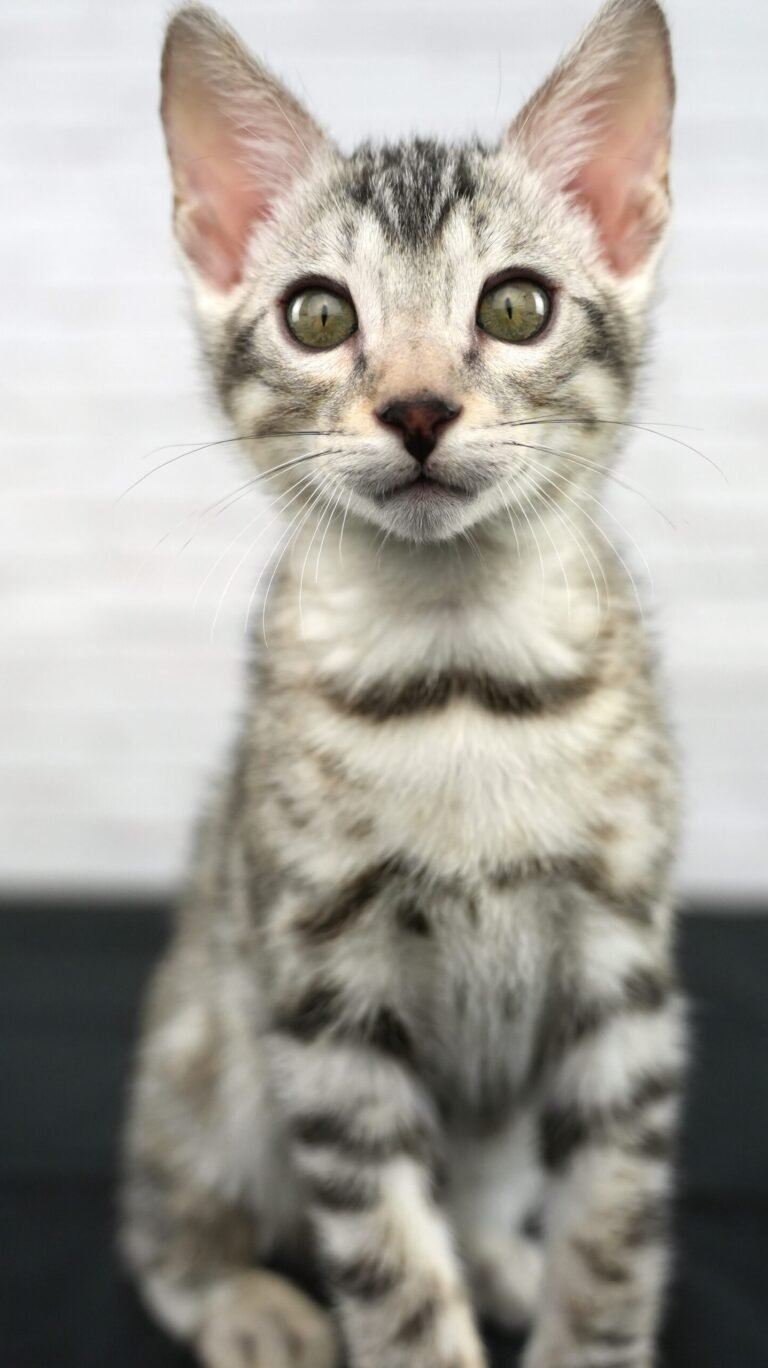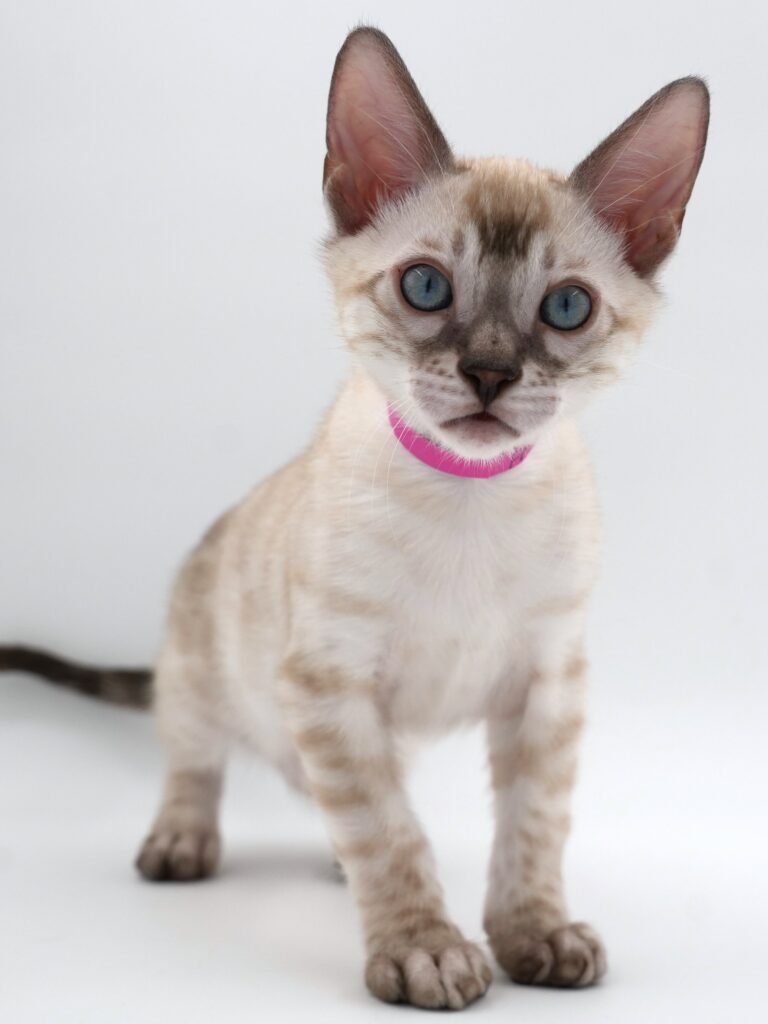Ready for Your Bengal: A Complete Guide to Kitten Preparation
Bringing a Bengal kitten home can be challenging, yet it’s an exciting and deeply rewarding experience. To ensure a seamless transition, it’s essential to create a safe, welcoming environment that aligns with their unique needs and natural behaviors.
This guide will help you prepare your home, focusing on setting up a secure kitten room and eliminating potential hazards, to help your Bengal kitten thrive from day one.
Schedule 96-Hour Vet Visit
Your Bengals will receive a Kitten Go Home (Exit) Veterinarian Clearance and must be declared healthy by our veterinarian before they are permitted to leave Pet Perfect Bengals Cattery.
However, you must arrange their first vet visit well before their arrival to ensure this appointment occurs within 96 hours of your kitten leaving Pet Perfect Bengals Cattery.
This initial exam is intended to verify the microchip number and establish a health baseline, and not for vaccinations or surgical procedures. The transition to a new home can be stressful for kittens, potentially weakening their developing immune systems and increasing their susceptibility to infections, which may manifest as diarrhea, vomiting, or loss of appetite.
By scheduling this appointment promptly, you avoid the typical delays faced by new patients and ensure immediate care. Prioritizing proactive care is essential for maintaining your kitten’s health and long-term well-being.
Contact your veterinarian today to schedule this crucial first examination
Purchasing Supplies
Equip your home with the right supplies for your Bengal kitten’s comfort and well-being. For a comprehensive list and information about the supplies you will need, please refer to Must have Bengal Kitten Supplies to ensure you’re fully prepared.
Review the supply list and begin purchasing the necessary items today.
General House Safety: Kitten Proofing the House
Before addressing specific safety measures, it’s important to understand why kitten-proofing your home is crucial. Bengal cats are inherently curious and will explore everything they can reach. This curiosity can lead them into potentially dangerous situations.
By identifying and removing hazards, you create a safe environment that allows your kitten to explore freely without risking their health or safety.
Toxins
- Foods Toxic to Cats: Secure all foods harmful to cats to prevent accidental ingestion.
- Toxic Plants: Remove any plants known to be toxic to cats.
- Medications and Supplements: Store all human medications and supplements in a locked cabinet.
- Essential Oils and Air Fresheners: Avoid using products containing essential oils around your kitten, as many can be toxic if inhaled or ingested.
- Household Chemicals and Cleaning Supplies: Store cleaning agents and chemicals in childproof cabinets or closets.
Hazards
- Small Objects: Secure all small items that could pose choking hazards.
- Strings and Feathers: Store items like strings and feather toys out of reach when not in use, allowing access only under supervision.
- Garbage and Recycling Bins: Use bins with secure lids to prevent kittens from accessing potentially harmful materials.
- Electrical Cords: Manage and protect all electrical wiring to prevent chewing, which can lead to electrical shock.
- Windows and Curtains: Ensure all windows have secure screens and keep curtain cords out of reach.
- Heating and Cooling Elements: Restrict access to heating and cooling devices to prevent burns and other injuries.
Walk through your home today, using this checklist to remove or secure potential hazards in each category. For more information visit Household Hazards.
Emergency Preparations
- Safety Devices: Regularly check that all safety devices, such as smoke detectors and carbon monoxide alarms, are functional and properly placed.
- Alert Sticker: Display a free emergency pet alert sticker on your home to inform rescue workers about the presence of pets inside.
- First Aid Kit: Include essential supplies in a pet first aid kit to handle minor injuries and health concerns.
- Disaster Kit: Prepare a pet disaster kit with resources to support your kitten for at least 72 hours during emergencies.
- Carrier: Keep an easily accessible carrier for rapid evacuation in case of emergencies.
- Emergency Contacts: Maintain a list of emergency contact numbers, such as the pet poison helpline, your veterinarian, and local animal hospitals.
- Optional Monitoring: Consider setting up monitoring systems like cameras to watch over your kitten when you are away.
Compile your emergency resources and contacts today, ensuring everything is readily accessible and up-to-date. For more information visit Disaster Preparedness
The Kitten Room: Creating a Cozy Haven
Now that your home is kitten-proofed and you have taken the necessary precautions, it’s time to focus on creating a designated space for your Bengal kitten, often affectionately called the “kitten room.” This area will serve as a secure and enriching environment, acting as a cozy haven where your kitten can feel safe, comfortable, and stimulated. A well-thought-out kitten room caters to your Bengal’s natural instincts to play, rest, and explore. It should be equipped with essential items like scratching posts, a variety of toys, and a cat tree, each playing a pivotal role in meeting your kitten’s specific needs and fostering healthy growth and development. As your kitten grows, they will gradually explore and become comfortable with the rest of your home, with the kitten room initially serving as a secure base before the entire house becomes their domain.
Selecting the Ideal Location for the Kitten Room
When choosing a spot for the kitten room, prioritize a quiet, low-traffic area that offers both tranquility and opportunities for exploration. The location should be free from excessive noise and distractions but spacious enough to accommodate cat trees, interactive toys, and ideally, a window. Access to natural light is important because it helps regulate your kitten’s sleep-wake cycle and provides mental stimulation. If natural light is limited, consider using soft, adjustable lighting to mimic daylight. Ensure the kitten room maintains a comfortable and stable temperature, 72-80°F for kittens 3-6 months and 70-80°F for kittens six months and older. The room should be easily accessible to you but isolated from other pets or young children, ensuring it remains a secure retreat for your kitten as they adjust to their new environment.
Assess potential locations for the kitten room and select the most suitable one based on these guidelines.
Cleaning and Sanitizing the Kitten Room
After choosing the perfect location, begin by clearing out the room to start with an empty space. Vacuum or sweep to capture loose debris, then mop or use a carpet cleaner to tackle any remaining dirt, with particular attention to corners, baseboards, and crevices, common spots where dirt collects. Next, sanitize all surfaces using a pet-safe disinfectant like Rescue, which is effective against pathogens and safe for pets. Ensure proper ventilation by opening windows or using an air purifier, allowing the room to air dry completely. This process keeps the environment clean and safe for your Bengal kitten.
Clean and sanitize the kitten room thoroughly today, following these steps to create a safe and welcoming environment for your kitten.
Equipping the Kitten Room with Essential Supplies
- Scratching Surfaces: Position multiple scratching posts and boards in visible and accessible areas to encourage use and protect your furniture.
- Cat Trees and Shelves: Install these at various heights, securely anchored, to provide safe climbing and viewing spots.
- Beds and Resting Areas: Distribute soft beds and blankets across different areas of the room for comfort and cleanliness.
- Litter Boxes: Set up multiple litter boxes in easy-to-access areas to ensure regular use and maintenance. Feeding and
- Hydration Area: Create a dedicated space for food and water, away from litter boxes, with options like a water fountain to promote hydration.
- Toys: Provide a selection of interactive and solo play toys throughout the kitten room, rotating them regularly to maintain interest. Pheromone Diffuser: Plug in the diffuser in the kitten room a week before your kitten arrives to help ease their adjustment.
A Marvelous Adventure
As you complete these preparations, remember that each step brings you closer to providing a safe, loving environment for your new Bengal kitten. By kitten-proofing your home and setting up the kitten room, you ensure that your Bengal’s introduction to their new life is as smooth and stress-free as possible.
Enjoy the process of creating a welcoming space, and eagerly anticipate the countless joyful moments and the deep bond you will build with your Bengal kitten. Welcome to the start of a marvelous adventure together!










